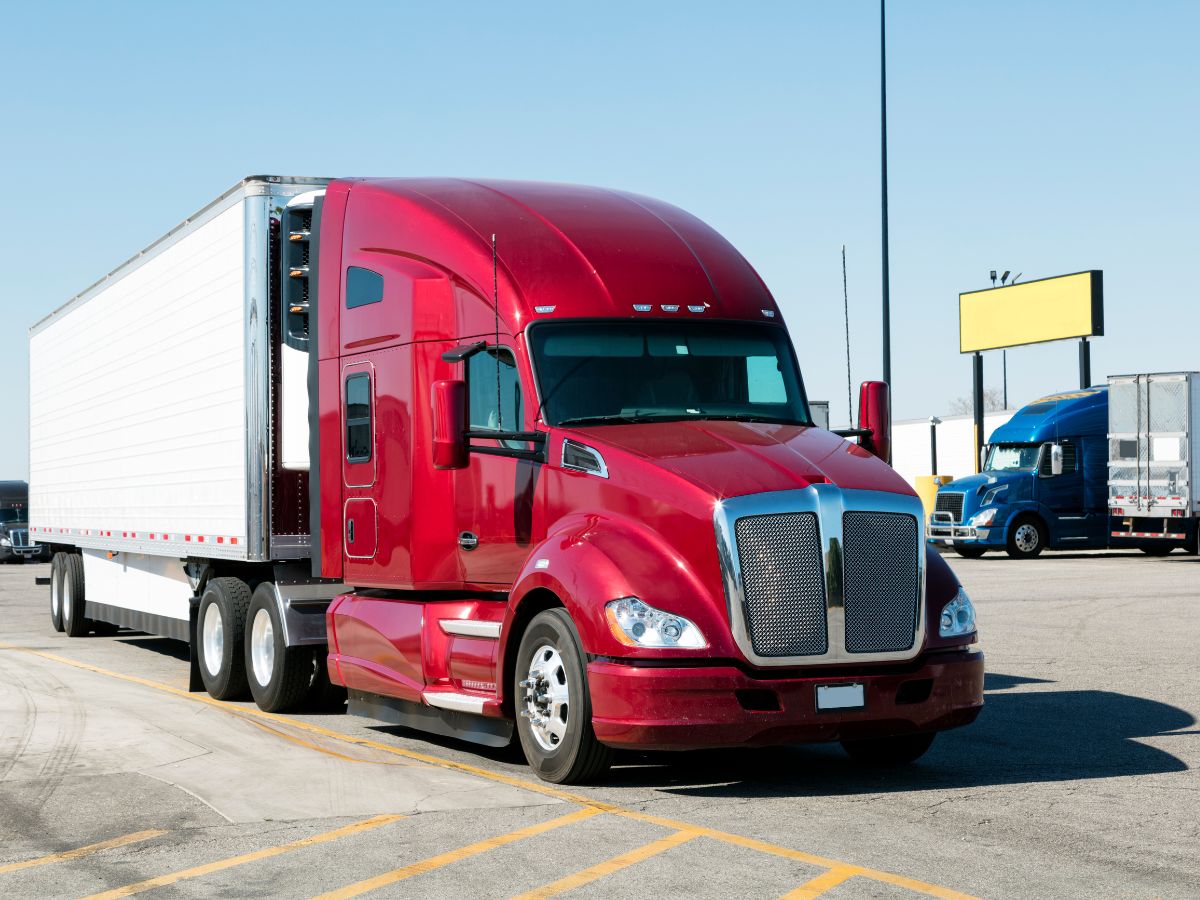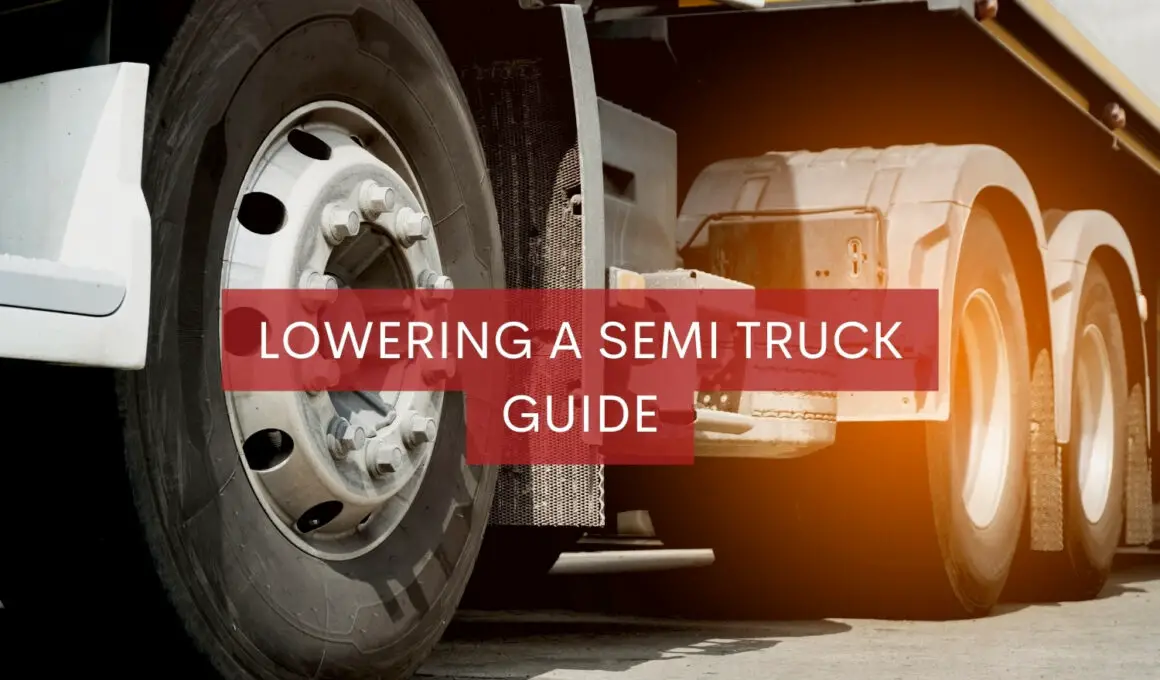In This Article Show
In my 13 years as a mechanic, I’ve had the pleasure of working on many vehicles, but tackling a semi-truck is something incredibly satisfying. The scale of the task, the complexity of the systems, the sheer power of these road titans, it’s a unique challenge that I absolutely relish.
Among the various modifications I’ve made on these machines, one consistently stands out for its blend of practicality and aesthetics: lowering a semi-truck.
When you first hear about lowering a semi-truck, you might be puzzled, possibly intrigued. After all, aren’t these vehicles supposed to be tall, imposing, and robust? What benefits could there possibly be to bringing them closer to the ground?
That’s exactly what we’re here to unpack today. Lowering a semi-truck might seem counterintuitive, but it’s an increasingly popular modification for many reasons. These range from the tangible, like improved fuel efficiency and stability, to the more subjective, like the enhanced sleek look that attracts many truckers.
However, there are potential considerations to bear in mind. We’re talking about a significant modification here, one that can affect everything from your truck’s warranty to its resale value. Not to mention, you also need to make sure your truck still complies with various legal requirements.
But don’t worry. With over a decade’s worth of hands-on experience in the field, I’m here to guide you through every step of the process. By the end of this comprehensive guide, you’ll clearly understand what lowering a semi-truck entails, why it might be beneficial, what precautions you need to take, and how to do it safely and effectively. Let’s dive in!
Understanding the Basics
Before we dive into the practicalities, it’s important to start with a fundamental understanding of what we mean when we talk about lowering a semi truck.
So, what does lowering a semi truck mean? Lowering a semi truck involves modifying its suspension system to reduce its ride height, bringing it closer to the ground. This is accomplished using various techniques and specialized equipment, which we’ll delve into later in this guide.
There are a few reasons why someone might choose to lower their semi truck.
Firstly, aesthetics. A lowered semi truck has a sleek, modern look that many truckers find appealing. It gives the vehicle a streamlined, custom feel that can be a significant draw for those who want their truck to stand out on the road.
But it’s not all about looks. Lowering a semi truck can have practical benefits too. For one, a lowered truck typically has a lower center of gravity, which can improve its stability, especially at high speeds or when navigating curves.
Another key benefit is fuel efficiency. The closer a truck is to the ground, the less wind resistance it faces, which can result in significant fuel savings over time. In an industry where fuel costs are a major operational expense, this advantage is hard to ignore.
Finally, it’s worth noting that this modification can affect the vehicle’s performance in various ways. Lowering a truck can lead to smoother handling and an overall more comfortable ride, particularly on highways. However, it’s important to keep in mind that it might not be ideal for off-road conditions or over rough terrain.
Understanding these basics is crucial in deciding whether lowering your semi truck is the right choice for you. It’s a decision that should be based on carefully considering both your aesthetic preferences and practical needs.
Pre-Lowering Considerations
Before diving into the process of lowering your semi truck, there are several key considerations to bear in mind. This process involves a significant modification to your vehicle, and it’s crucial to understand the potential impacts and responsibilities that come along with it.
Legalities and Regulations
The first thing to note is the legality of lowering your semi truck. The rules vary by country, state, or even city, so it’s vital to check local regulations before proceeding.
In some regions, vehicles must maintain a certain minimum ground clearance, and there may be restrictions on changes to the suspension system. Ensure you know these limitations to avoid running into any legal issues down the line.
Insurance and Warranties
Next, consider how lowering your truck may affect your insurance and any existing warranties. Some insurance companies may change your policy or premiums if you alter your vehicle significantly.
As for warranties, vehicle manufacturers often stipulate that any modifications can void the warranty. Therefore, if your semi truck is still under warranty, it’s a good idea to consult with your dealer or manufacturer before moving ahead with lowering your truck.
Resale Value
Lastly, think about how this modification might impact your semi truck’s resale value.
While a lowered truck may be more attractive to some buyers due to its modern look and potentially improved fuel efficiency, others may be wary of modified vehicles. Additionally, if the job is not done professionally, it could reduce the value of your truck.
These considerations are crucial to understand before you commit to lowering your semi truck. The process is more than just a simple modification; it’s a decision that can have a lasting impact on your vehicle and its operation.
Ensuring you’ve weighed these factors beforehand will lead to a smoother, more informed process as you move ahead with your plans.
Necessary Tools and Equipment for Lowering a Semi Truck
Once you’ve considered the pre-lowering implications and have decided to proceed, the next step involves gathering all the necessary tools and equipment. A project like this requires precision and, as such, the right tools are vital for a successful outcome.
A Comprehensive Checklist of Tools Required
Here are the basic tools you’ll need for lowering a semi-truck:
Lowering kit
This is the main equipment needed. It includes all the parts necessary for lowering your truck. The contents of the kit can vary based on the truck model and the degree of lowering required.
Standard mechanic tool set
This typically includes a variety of wrenches, socket sets, pliers, screwdrivers, and more.
Floor jack and jack stands are essential for safely lifting and supporting the truck during the lowering process.
Torque wrench
This ensures that all bolts and nuts are tightened to the manufacturer’s specifications, an essential part of safe vehicle modifications.
Pry bar
Useful for dislodging stubborn parts during the process.
Safety glasses and gloves
Personal protective equipment is crucial to ensure your safety during the process.
Identifying Quality Equipment and Where to Purchase Them
When it comes to purchasing these tools, quality is key. Look for well-reviewed, reputable brands to ensure your tools can handle the task at hand. Online retailers, automotive stores, and specialty tool shops are all good places to start your search.
As for the lowering kit, ensure you’re purchasing one designed for your specific truck model to guarantee compatibility. Reputable automotive parts stores and online retailers usually offer a range of options.
Safety Gear and Precautions
Safety should be your top priority when embarking on a project like this.
Always use your safety glasses and gloves, and never work under your vehicle unless it’s securely supported by jack stands. Make sure your working area is well-ventilated and free of any potential hazards.
With all your tools and safety gear ready, you’re well-prepared for the task ahead.
Step-by-Step Guide to Lowering a Semi Truck
Now that you’re equipped with all the necessary tools and information, let’s move on to the actual process of lowering your semi truck. Here is a step-by-step guide:
Preparation: Choosing a Safe Work Area and Prepping the Truck
- Choose a safe, flat, and stable surface to work on, ideally a garage or a flat driveway.
- Ensure the area is well-ventilated and lit.
- Apply the parking brake to secure the truck.
Removing the Existing Suspension
- Raise the vehicle off the ground using a floor jack and secure it with jack stands. Never work under a vehicle supported only by a jack.
- Remove the wheels to gain access to the suspension components.
- Starting with the rear suspension, remove the bolts attaching the leaf springs or air springs (depending on your truck’s suspension type) to the axle.
- Carefully lower the axle, ensuring the brake lines or ABS cables are not stretched or damaged.
- Once the axle is lowered, remove the existing springs.
Installing the Lowering Kit
- Begin installing the lowering kit by attaching the new, shorter springs to the axle. These will reduce the ride height of your semi truck.
- If your kit includes new hangers or shackles, install these next. They help adjust the angle of the leaf springs and further decrease the ride height.
- Repeat the process on the front suspension. Depending on your truck’s configuration, this might involve replacing coil springs or installing lowering spindles.
- Once all the components are installed, carefully raise the axle back into position, ensuring the new suspension components align correctly.
- Replace the bolts you removed earlier, securing the new suspension components. Use a torque wrench to tighten them to the manufacturer’s specifications.
Inspecting the Work and Making Necessary Adjustments
- Once everything is tightened, reattach the wheels.
- Lower the truck off the jack stands using the floor jack.
- Inspect the ride height to confirm it has been lowered to your desired level.
- Take a slow, careful test drive to ensure everything feels right. Pay attention to any unusual noises or feelings, which might indicate a need for further adjustment.
Please remember, this process requires great precision and careful handling. If you are not entirely comfortable doing this yourself, it is advisable to hire a professional.

Post-Lowering Maintenance and Adjustments
Successfully lowering your semi truck is a major accomplishment, but it’s just the beginning of your journey. There are several key maintenance and adjustment steps to ensure that your modified truck continues operating smoothly and safely.
Initial Checkup and Readjustments
Alignment
After lowering your semi-truck, the vehicle’s alignment can be off. An alignment adjustment ensures your truck drives straight and reduces premature tire wear. A professional should do this at a service center.
Inspect for Clearance
Double-check all areas of the truck for clearance. This includes brake lines, fuel lines, driveshaft, exhaust, and body parts. Look for anything that may rub or get caught while driving.
Shock Absorbers
When a truck is lowered, the stock shock absorbers may no longer be the correct length. If the shocks are too long, they can bottom out and cause damage. Consider replacing them with shocks designed for lowered vehicles.
Ongoing Maintenance Requirements for a Lowered Semi Truck
Frequent Check-ups
Lowered trucks require more frequent inspections due to their decreased ground clearance. Regularly inspect the undercarriage for potential damage from speed bumps or uneven road surfaces.
Tire Maintenance
Lowered trucks can wear tires unevenly if the alignment is not perfect. Regularly rotate your tires and keep an eye out for any unusual wear patterns.
Suspension Component Checks
Regularly inspect all suspension components for signs of wear and tear. This includes bushings, springs, shocks, and any other components that were replaced during the lowering process.
Monitoring Wear and Tear
Inspect Regularly
Regular inspections are critical to ensure the longevity of your truck. Check for any signs of wear and tear or damage, and address them immediately.
Listen for Noises
Unusual noises can be the first sign of a problem. Listen for anything unusual, particularly during turning or driving over bumps.
Maintaining your lowered semi truck might require a bit more attention than a standard truck, but the benefits often outweigh the added effort.
Frequently Asked Questions
Will lowering my semi truck affect its towing capacity?
Lowering a semi truck can potentially impact its towing capacity. A lower suspension can alter the truck’s weight distribution and overall stability while towing. If you frequently use your truck for heavy towing, discussing this with a professional before proceeding with any modifications is crucial.
Is lowering a semi truck legal?
The legality of lowering a semi truck varies by region. It’s essential to check local regulations regarding vehicle height and suspension modifications before proceeding. You should also be aware that lowered trucks may not be allowed on certain roads or in specific areas due to their reduced ground clearance.
Can I lower my semi truck myself, or do I need to hire a professional?
While it’s technically possible to lower a semi-truck yourself, it’s a complex job requiring significant expertise and the right tools. Hiring a professional is recommended if you’re not entirely comfortable doing it yourself.
Will lowering my semi truck void its warranty?
Many vehicle manufacturers stipulate that modifications, including lowering the vehicle, can void the warranty. If your semi-truck is under warranty, consult with your dealer or manufacturer before making any modifications.
Will lowering my semi truck improve its fuel efficiency?
Lowering a semi-truck can reduce wind resistance, which may result in improved fuel efficiency. However, the actual savings will depend on various factors, including how much the truck is lowered, the driving you do, and the specific design of your truck.
Wrapping it up
Lowering a semi-truck is a considerable modification that involves understanding the basics, critical pre-lowering considerations, the right tools and equipment, meticulous step-by-step execution, and diligent post-lowering maintenance.
This comprehensive guide aims to help you navigate this process, from start to finish, effectively. Remember, safety and legality should always be your top priority.
















